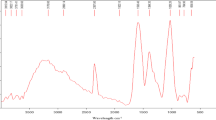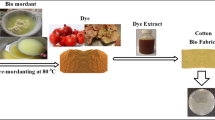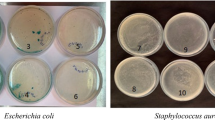Abstract
Application of natural dyes for textiles is increasing due to awareness of environment, ecology, and pollution control. The purpose of this study is to determine the color, antimicrobial, and fastness properties of cotton fabrics dyed with thyme and pomegranate peel without a mordanting process. In this way, it was planned to avoid use of metallic mordants (heavy-metal salts) and prevent heavy-metal pollution for ecological production. Additionally, a variety of the most commonly used mordants, namely potassium aluminum sulfate, copper(II) sulfate, iron(II) sulfate, and tin(II) chloride, were used for mordanting of cotton fabrics in order to compare the differently mordanted and unmordanted dyed fabrics’ color efficiencies (K/S) and CIE L * a * b * color values. It was found that mordant type had an effect on color efficiency and the color coordinates of fabrics dyed with both thyme and pomegranate fruit peel. Moreover, the antimicrobial properties of the fabrics only dyed directly with thyme and pomegranate peel without any mordanting process were determined to demonstrate the usability of these natural dye sources without use of any mordanting agents. The obtained antimicrobial activities were compared with undyed samples. Undyed samples showed no antimicrobial activity, whereas significant antimicrobial activity was obtained after the dyeing procedure using thyme and pomegranate peel on unmordanted fabrics. Washing, rubbing, perspiration, and lightfastness properties of dyed fabrics were also evaluated. Thyme and pomegranate fruit peel as natural dye sources revealed sufficient results even for unmordanted samples.





Similar content being viewed by others
References
AATCC Test Method 100-1999 (1999) Antimicrobial Finishes on Textile Materials: Assessment of (NC:AATCC 1999)
Adeel S, Ali S, Bhatti IA, Zsila F (2009) Dyeing of cotton fabric using Pomegranate (Punica granatum) aqueous extract. Asian J Chem 21(5):3493–3499
Agarwal BJ, Bhattacharya SD (2010) Possibilities of polymer-aided dyeing of cotton fabric with reactive dyes at neutral pH. J Appl Polym Sci 118:1257–1269
Ahmed HE (2009) History of Natural Dyes in North Africa ‘Egypt’, In: Bechtold T, Mussak R (eds) Hand book of natural colorants, Wiley, UK, p. 35 (ISBN: 978-0-470-51199-2)
Alçiçek Z (2011) The effects of thyme (Thymus vulgaris L.) oil concentration on liquid-smoked vacuum-packed rainbow trout (Oncorhynchus mykiss Walbaum, 1792) fillets during chilled storage. Food Chem 128(3):683–688
Ali S, Hussain T, Nawaz R (2009) Optimization of alkaline extraction of natural dye from Henna leaves and its dyeing on cotton by exhaust method. J Clean Prod 17(1):61–66
Al-Zoreky NS (2009) Antimicrobial activity of pomegranate (Punica granatum L.) fruit peels. Int J Food Microbiol 134(3):244–248
Bahtiyari Mİ, Benli H, Sen Y (2012) Use of thyme as a natural dye in wool dyeing and evaluation of antimicrobial effect, International Congress on Healthcare and Medical Textiles (MEDITEX), İzmir, Turkey (oral presentation)
Bechtold T, Turcanu A, Ganglberger E, Geissler S (2003) Natural dyes in modern textile dyehouses—how to combine experiences of two centuries to meet the demands of the future? J Clean Prod 11(5):499–509
Chung C, Lee M, Choe EK (2004) Characterization of cotton fabric scouring by FT-IR ATR spectroscopy. Carbohydr Polym 58:417–420
Cook JG (1993) Handbook of textile fibres: I. Natural fibres, 5th edn. repr., Merrow, Durham, England, pp. 79–132
Cristea D, Vilarem G (2006) Improving light fastness of natural dyes on cotton yarn. Dyes Pigm 70(3):238–245
Das D, Bhattacharya SC, Maulik SC (2006) Dyeing of wool and silk with Punica granatum. Indian J Fiber Text Res 31(12):559–564
Gupta D, Khare SK, Laha A (2004) Antimicrobial properties of natural dyes against Gram-negative bacteria. Color Technol 120(4):167–171
Ibrahim NA, El-Gamel AR, Gouda M, Mahrous F (2010) A new approach for natural dyeing and functional finishing of cotton cellulose. Carbohydr Polym 82(4):1205–1211
ISO 105-C01 (1989) Textiles–tests for color fastness. Part C01: Color fastness to washing: Test 1 (Geneva: ISO 1989)
ISO 105-X12 (1993) Textiles–tests for color fastness, Part X12: Color fastness to rubbing (Geneva: ISO 1993)
ISO 105-B02 (1994) Textiles–tests for color fastness, Part B02: Color fastness to artificial light (Geneva: ISO 1994)
ISO 105-E04 (1994) Textiles–tests for color fastness, Part E04: Color fastness to perspiration (Geneva: ISO 1994)
Karmakar SR (1999) Chemical technology in the pre-treatment processes of textiles. In: Textile science and technology series, Vol. 12., 1st edn, Elsevier Science, Amsterdam, The Netherlands, pp. 107–113
Komboonchoo S, Bechtold T (2009) Natural dyeing of wool and hair with indigo carmine (C.I. Natural Blue 2), a renewable resource based blue dye. J Clean Prod 17(16):1487–1493
Kulkarni SS, Gokhale AV, Bodake UM, Pathade GR (2011) Cotton dyeing with natural dye extracted from pomegranate (Punica granatum) peel. Univers J Environ Res Technol 1(2):135–139
Lansky EP, Newman RA (2007) Punica granatum (pomegranate) and its potential for prevention and treatment of inflammation and cancer. J Ethnopharmacol 109(2):177–206
Lee SJ, Umano K, Shibamoto T, Lee KG (2005) Identification of volatile components in basil (Ocimum basilicum L.) and thyme leaves (Thymus vulgaris L.) and their antioxidant properties. Food Chem 91(1):131–137
Martínez JJ, Melgarejo P, Hernández F, Salazar DM, Martínez R (2006) Seed characterisation of five new pomegranate (Punica granatum L.) varieties. Sci Hortic 110(3):241–246
McDonald R (1997) Recipe prediction for textiles, In: McDonald R (ed) Colour physics for industry, 2nd edn, Society of Dyers and Colourists, Bradford, England, pp. 209–291 (ISBN 0 901956 70 8)
Mewes S, Krüger H, Pank F (2008) Physiological, morphological, chemical and genomic diversities of different origins of thyme (Thymus vulgaris L.). Genet Resour Crop Evol 55(8):1303–1311
Morimoto Y, Ono K, Arita D (2011) Dyeing in computer graphics, In: Kumbasar EPA (ed) Natural dyes, In Tech, Croatia, pp. 29–56 (ISBN 978-953-307-783-3)
Negi PS, Jayaprakasha GK (2003) Antioxidant and antibacterial activities of Punica granatum peel extracts. J Food Sci 68(4):1473–1477
Onar N, Aksit AC, Sen Y, Mutlu M (2011) Antimicrobial, UV-protective and self-cleaning properties of cotton fabrics coated by dip-coating and solvothermal coating methods. Fibers Polym 12(4):461–470
Perincek S, Bahtiyari Mİ, Körlü A, Duran K (2009) New techniques in cotton finishing. Text Res J 79(2):121–128
Rababah TM, Banat A, Ereifej K, Yang W (2010) Optimization of extraction conditions of total phenolics, antioxidant activities and anthocyanin of oregano, thyme, terebinth and pomegranate. J Food Sci 75(7):626–632
Samanta AK, Konar A (2011) Dyeing of textiles with natural dyes, In: Kumbasar EPA (ed), Natural dyes, In Tech, Croatia, p. 30 (ISBN 978-953-307-783-3)
Saravanan D, Sivasaravanan S, Sudharshan Prabhu M, Vasanthi NS, Senthil Raja K, Das A, Ramachandran T (2012) One-step process for desizing and bleaching of cotton fabrics using the combination of amylase and glucose oxidase enzymes. J Appl Polym Sci 123:2445–2450
Simoncic B, Tomsic B (2010) Structures of novel antimicrobial agents for textiles—A review. Text Res J 80(16):1721–1737
Singh R, Jain A, Panwar S, Gupta D, Khare SK (2005) Antimicrobial activity of some natural dyes. Dyes Pigm 66(2):99–102
Smith KJ (1997) Colour order systems, colour spaces, colour difference and colour scales, In: McDonald R (ed) Colour physics for industry 2nd edn, Society of Dyers and Colourists, Bradford, England, pp. 121–208 (ISBN 0-901956-70-8)
Solomakos N, Govaris A, Koidis P, Botsoglou N (2008) The antimicrobial effect of thyme essential oil, nisin, and their combination against Listeria monocytogenes in minced beef during refrigerated storage. Food Microbiol 25(1):120–127
Tiwari HC, Singh P, Mishra PK, Srivastava P (2010) Evaluation of various techniques for extraction of natural colorants from pomegranate rind-ultrasound and enzyme assisted extraction. Indian J Fibre Text Res 35(3):272–276
Ursache M, Loghin C, Mureşan R, Cerempeı A, Mureşan A (2011) Investigation on the effects of antibacterial finishes on dyed cotton knitted fabrics. Tekstil ve Konfeksiyon 21(3):249–256
Wang Q, Fan X, Gao W, Chen J (2006) Characterization of bioscoured cotton fabrics using FT-IR ATR spectroscopy and microscopy techniques. Carbohydr Res 341:2170–2175
Zeković Z, Lepojević Ž, Vujić DI (2000) Supercritical extraction of thyme (Thymus vulgaris L.). Chromatographia 51(34):175–179
Author information
Authors and Affiliations
Corresponding author
Rights and permissions
About this article
Cite this article
Davulcu, A., Benli, H., Şen, Y. et al. Dyeing of cotton with thyme and pomegranate peel. Cellulose 21, 4671–4680 (2014). https://doi.org/10.1007/s10570-014-0427-8
Received:
Accepted:
Published:
Issue Date:
DOI: https://doi.org/10.1007/s10570-014-0427-8




